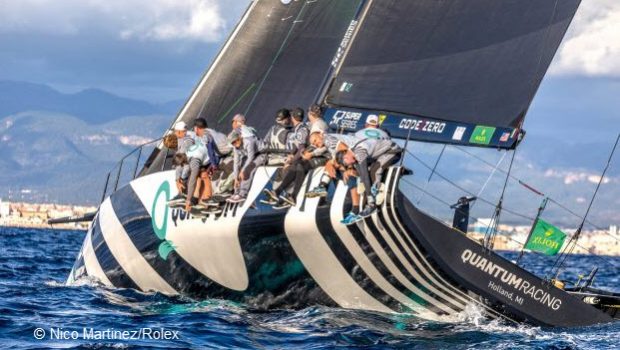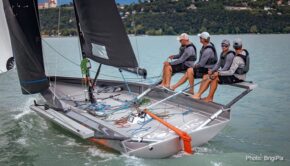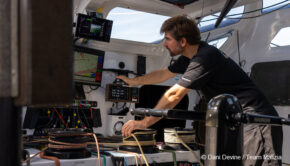How TP52 fleet uses America’s Cup tech
Published on May 19th, 2022
The ‘trickle down’ from the America’s Cup once meant equipment developed for the teams would, after the competition, reach the recreational market. Massive advancements, often using team money, fueled new products from the marine industry. These were the good ole days.
While the America’s Cup boats, along with pretty much everything else about the event, now hardly resembles the sport most people enjoy, the trickle down continues. What works at the highest level works even better down the ladder… you just need money.
Since a requirement to compete in the TP52 Class is deep pockets, in this report by Helen Fretter for Yachting World, she finds out how America’s cup surveillance tactics are used to find marginal gains in the TP52 fleet as they chase that final one percent:
As the TP52 fleet sweeps around the bottom mark off Palma, eyes turn to the sky. This isn’t a predictable day’s racing in Mallorca. The 2021 Rolex TP52 World Championships were – unusually – held in early November, and the summer sea breezes that crews are used to have been replaced by a shifty, chilly, offshore wind that is fluctuating from eight and 18 knots.
It’s a mentally taxing scenario for the tacticians, who rank among the best in the world: Francesco Bruni, Tom Slingsby, Terry Hutchinson. This is the most competitive inshore racing in the world, and place gains and losses are decided on margins of inches.
Fluffy clouds are forming over the Bay’s north-western shore, and the Quantum Racing team scan the course for clues. The decision on which headsail to use on the next beat is toss-a-coin marginal.
Numbers are called thick and fast, in clear specifics: “There’s 900kg on the mainsheet right now.” Load readings from the runners, diagonals and deflectors, along with angles, margins to competitors… It’s a constant stream of information that captures the stresses and speeds the carbon boat is undergoing in minute detail. But we’re not on the TP52, we’re on a hard-topped chase RIB a few hundred metres away.
The TP52 coach boat
All this data is streaming live from sensors all over the yacht to the RIB, where it is monitored by Quantum Racing’s performance team on laptops and iPads as we thunder around the short windward/leeward course.
It’s a set-up usually seen on America’s Cup chase boats tracking foiling test-runs, but here it’s deployed in a 52ft, conventional keeled, box rule fleet about to compete in its 17th year of European racing. These boats have raced each other hundreds of times – what secrets can possibly still be left to be discovered? – Full report









 We’ll keep your information safe.
We’ll keep your information safe.